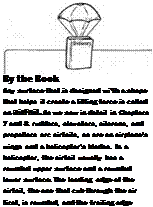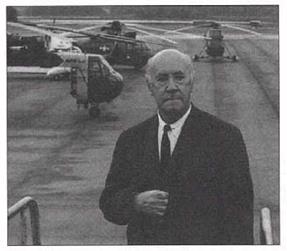How Helicopters Fly?
|
|
In This Chapter
► Helicopters: more agile and versatile than airplanes
► The Russian immigrant who launched the American helicopter industry >• The aerodynamics of helicopter flight
V Mythbusb’ng: engine failures and autorotation
Helicopter pilots and fanciers get plenty of ribbing from airplane folk. Airplane pilots like to say that, to be technically correct, helicopters don’t actually “fy”: They beat the air into submission. Others joke that helicopters don’t use aerodynamics to fly: It’s just that they’re so ugly they repel the ground.
What’s behind the light-hearted rivalry between fixed-wing and rotary-wing pilots? In a word, jealousy. The envy is on both sides. Airplanes fly faster than helicopters, they fly more smoothly, and they can dazzle spectators with wild feats of aerobatics. On the other hand, helicopters possess versatility that airplanes don’t. They are able to take off and land almost vertically. That means they can safely make their way into small clearings and building tops that airplane pilots can only dream of. A helicopter pilot on a leisurely flight up the beautiful Pacific coast of California, for example, can land on a deserted stretch of beach for a picnic lunch.
And, contrary to the common myth, helicopters don’t “fall out of the sky” if they lose engine power. They glide downward quite safely using a technique called autorotation, which we’ll discuss later in this chapter.
|
Igor Sikorsky’s Wild Ride
By the Book Heavier-than-air craft which doesn’t include balloons and airships, fall into one of two categories—fixed-wing and rotary-wing. Fbced-wfng craft are those aircraft that get their lift from wings that don’t move, while the lift-producing surfaces of rotary-wing craft spin around. Airplanes and gliders have fixed wings, while helicopters have rotary wings. |
Remember Leonardo da Vinci’s first helicopter, which we discussed in Chapter 1, “The Earliest Aviators”? Well, it wasn’t a very workable design, but it was one of the first sophisticated approaches to flying by using a rotating airfoil.
The idea was knocked around for a few hundred years until the twentieth century, when a gifted engineer named Igor Sikorsky cobbled together the first practical prototype of a modern helicopter.
Sikorsky was born in Kiev, in what is now Ukraine, in 1889. As a youngster, he read Jules Verne’s air adventures and learned of Leonardo da Vinci’s speculations on flight. Sikorsky was energized by news of the Wrights’ flight in the United States and mesmerized by the dirigibles that Count Ferdinand von Zeppelin was building in Germany. His early enthusiasm for flying turned Sikorsky toward a career in aviation, where he excelled.
|
In his later years, Igor Sikorsky could look back at three major advances in aviation that he helped pioneer: multiengine airplanes, seagoing Clipper airplanes, and helicopters. |
 |
After graduating from engineering college in St. Petersburg, Sikorsky tinkered with his helicopter designs. He built his first one, a flop, in 1909, at about the time pilots in Europe were first managing to duplicate the Wright brothers’ controlled flight in a fixed-wing craft. Sikorsky built another helicopter in 1910, which actually managed to get off the ground, but only after he found a featherweight pilot brave—or foolhardy—enough to get into it.
Frankly, neither Sikorsky nor anyone else at the time knew enough about rotary-wing aerodynamics or engine design to provide a ghost of a chance of building a workable commercial helicopter.
 |
Sikorsky put aside his helicopter work for a while and turned toward fixed-wing projects. In 1913, while working for a Russian railroad company, he built the world’s first multiengine airplane, which featured a revolutionary enclosed cabin that enabled passengers to fly in comfort. It also featured an outdoor balcony equipped with a search light that allowed passengers to sightsee in daylight or at night. Sikorsky’s plane even included the world’s first airplane restroom!
|
By the Book |
Helicopters receive their primary lifting force from one or more rotors, which are made up of long blades shaped so they will produce aerodynamic lift when rotated. That might sound simple, but crafting a rotor that not only produces lift but also is capable of increasing or decreasing its lift depending on pilot control, or is able to tilt toward the front back, and sides for maneuverability, was perhaps the greatest engineering feat in aviation until the invention of the moon rockets.
Years later, Sikorsky turned his mind to bridging the ocean barrier between continents. From his New York factory not far from the same Roosevelt Field where Charles Lindbergh later departed for his historic Atlantic crossing (see Chapter 5, “Lindbergh, Earhart, and the Rise of the Airlines,” for the full rundown on Lindbergh’s flight), Sikorsky worked on designs for the “flying boats” that would later gain fame as the Pan American Clippers.
The success of the Clipper aircraft enabled Sikorsky to return, once and for all, to serious work on the helicopters that had fascinated him since his youth in Russia.
In 1931, Sikorsky patented the familiar pattern of one main rotor and one tail rotor. In 1939, his first prototype succeeded in flying for the first time. Over the next few years and following a number of crashes and continued refinement, Sikorsky designed the S-4, which became the first helicopter to be mass-produced.















